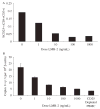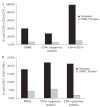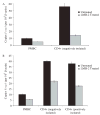Selective elimination of human regulatory T lymphocytes in vitro with the recombinant immunotoxin LMB-2
- PMID: 16531821
- PMCID: PMC1473974
- DOI: 10.1097/01.cji.0000187959.45803.0c
Selective elimination of human regulatory T lymphocytes in vitro with the recombinant immunotoxin LMB-2
Abstract
CD4(+)CD25(+) T-regulatory cells (T(reg)) can inhibit the proliferation and cytokine secretion of CD4(+)CD25(-) helper T cells in mice and humans. In murine tumor models, the presence of these T(reg) cells can inhibit the antitumor effectiveness of T-cell transfer and active immunization approaches. We have thus initiated efforts to eliminate T(reg) cells selectively from human peripheral blood mononuclear cells (PBMCs) to potentially bolster antitumor responses. LMB-2 is a recombinant immunotoxin that is a fusion of a single-chain Fv fragment of the anti-Tac anti-CD25 monoclonal antibody to a truncated form of the bacterial Pseudomonas exotoxin A. In vitro incubation of human PBMCs with LMB-2 reduced the levels of CD4(+)CD25(+) and Foxp3-expressing cells without impairing the function of the remaining lymphocytes. The short in vivo half-life of LMB-2 makes it an attractive candidate for reducing human T(reg) cells in vivo before the administration of cancer vaccine or cell transfer immunotherapy approaches.
Figures




Similar articles
-
Administration of a CD25-directed immunotoxin, LMB-2, to patients with metastatic melanoma induces a selective partial reduction in regulatory T cells in vivo.J Immunol. 2007 Oct 1;179(7):4919-28. doi: 10.4049/jimmunol.179.7.4919. J Immunol. 2007. PMID: 17878392 Free PMC article. Clinical Trial.
-
In vitro selective depletion of CD4(+)CD25(+) regulatory T-cells from PBMC using anti-tac-SAP.J Immunotoxicol. 2012 Oct-Dec;9(4):368-73. doi: 10.3109/1547691X.2012.668974. Epub 2012 Apr 17. J Immunotoxicol. 2012. PMID: 22506556
-
Partial reduction of human FOXP3+ CD4 T cells in vivo after CD25-directed recombinant immunotoxin administration.J Immunother. 2008 Feb-Mar;31(2):189-98. doi: 10.1097/CJI.0b013e31815dc0e8. J Immunother. 2008. PMID: 18481388 Free PMC article. Clinical Trial.
-
CD4(+)CD25 (+) regulatory T cells in human lupus erythematosus.Arch Dermatol Res. 2009 Jan;301(1):71-81. doi: 10.1007/s00403-008-0891-9. Epub 2008 Nov 5. Arch Dermatol Res. 2009. PMID: 18985367 Review.
-
Clinical use of anti-CD25 antibody daclizumab to enhance immune responses to tumor antigen vaccination by targeting regulatory T cells.Ann N Y Acad Sci. 2009 Sep;1174:99-106. doi: 10.1111/j.1749-6632.2009.04939.x. Ann N Y Acad Sci. 2009. PMID: 19769742 Review.
Cited by
-
T-regulatory cells: key players in tumor immune escape and angiogenesis.Cancer Res. 2012 May 1;72(9):2162-71. doi: 10.1158/0008-5472.CAN-11-3687. Cancer Res. 2012. PMID: 22549946 Free PMC article. Review.
-
Administration of a CD25-directed immunotoxin, LMB-2, to patients with metastatic melanoma induces a selective partial reduction in regulatory T cells in vivo.J Immunol. 2007 Oct 1;179(7):4919-28. doi: 10.4049/jimmunol.179.7.4919. J Immunol. 2007. PMID: 17878392 Free PMC article. Clinical Trial.
-
Synergistic antitumor activity of anti-CD25 recombinant immunotoxin LMB-2 with chemotherapy.Clin Cancer Res. 2012 Jan 1;18(1):152-60. doi: 10.1158/1078-0432.CCR-11-1839. Epub 2011 Nov 8. Clin Cancer Res. 2012. PMID: 22068660 Free PMC article.
-
Tumor cell lysate induces the immunosuppression and apoptosis of mouse immunocytes.Mol Med Rep. 2014 Dec;10(6):2827-34. doi: 10.3892/mmr.2014.2606. Epub 2014 Oct 2. Mol Med Rep. 2014. PMID: 25310154 Free PMC article.
-
Imatinib mesylate inhibits CD4+ CD25+ regulatory T cell activity and enhances active immunotherapy against BCR-ABL- tumors.J Immunol. 2008 Nov 15;181(10):6955-63. doi: 10.4049/jimmunol.181.10.6955. J Immunol. 2008. PMID: 18981115 Free PMC article.
References
-
- Sakaguchi S. Naturally arising CD4+ regulatory T cells for immunologic self-tolerance and negative control of immune responses. Annu Rev Immunol. 2004;22:531–562. - PubMed
-
- Sakaguchi S. Naturally arising Foxp3-expressing CD25+CD4+ regulatory T cells in immunological tolerance to self and non-self. Nat Immunol. 2005;6:345–352. - PubMed
-
- Bennett CL, Christie J, Ramsdell F, et al. The immune dysregulation, polyendocrinopathy, enteropathy, X-linked syndrome (IPEX) is caused by mutations of FOXP3. Nat Genet. 2001;27:20–21. - PubMed
-
- Wang HY, Lee DA, Peng G, et al. Tumor-specific human CD4+ regulatory T cells and their ligands: implications for immunotherapy. Immunity. 2004;20:107–118. - PubMed
Publication types
MeSH terms
Substances
Grants and funding
LinkOut - more resources
Full Text Sources
Other Literature Sources
Research Materials

